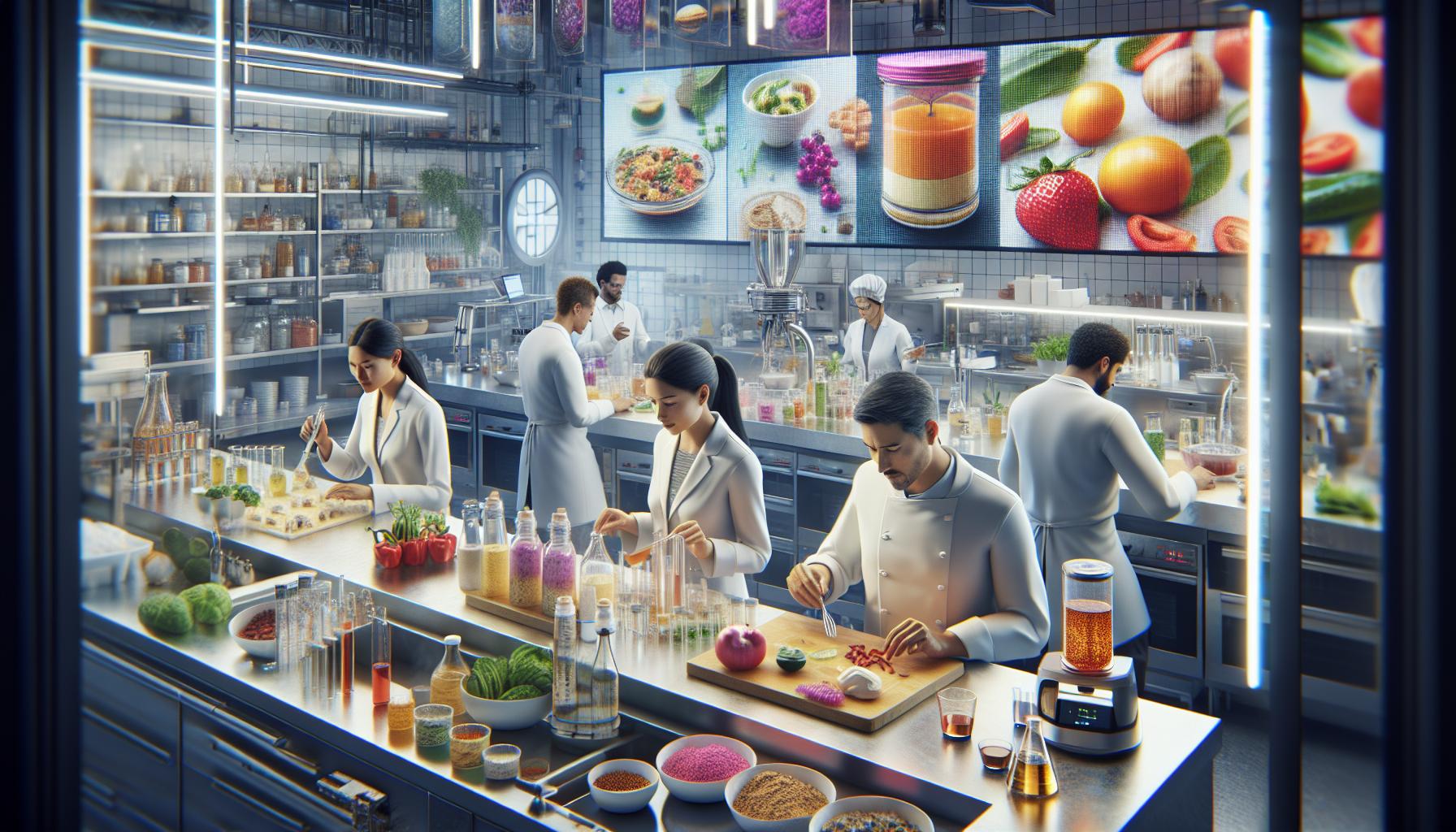Food and Beverage Innovation
- Emphasis on Sustainability: The food and beverage industry prioritizes eco-friendly practices, such as regenerative agriculture and innovative packaging, to minimize environmental impacts.
- Health-Conscious Trends: Increasing awareness of nutrition among consumers drives demand for plant-based alternatives, superfoods, and functional beverages that promote wellness.
- Technological Integration: Automation, artificial intelligence, and blockchain are revolutionizing food production and distribution, improving efficiency and product quality throughout the supply chain.
- Flavor and Ingredient Innovation: Chefs and food scientists are experimenting with unique ingredient combinations, leading to exciting new culinary experiences that cater to adventurous eaters.
- Consumer Behavior Shifts: Trends toward convenience and accessibility are reshaping purchasing decisions, with a growing preference for ready-to-eat meals and online grocery shopping.
- Challenges and Competition: Regulatory hurdles and market saturation require companies to innovate continuously and differentiate their offerings to maintain consumer interest and loyalty.
In a world where culinary boundaries are constantly pushed, food and beverage innovation stands at the forefront of the industry. Chefs and entrepreneurs alike are reimagining traditional dishes while embracing new technologies and sustainable practices. This dynamic evolution not only enhances flavors but also transforms how consumers experience food and drink.
As trends shift and consumer preferences evolve, the demand for unique and healthier options grows. From plant-based alternatives to lab-grown meats, the landscape of food and beverages is rapidly changing. This article delves into the latest innovations, exploring how creativity and technology are reshaping the way we eat and drink, and what it means for the future of gastronomy.
Overview of Food and Beverage Innovation
Food and beverage innovation encompasses transformative changes in practices, products, and experiences within the industry. It involves the utilization of cutting-edge technologies and methods to meet evolving consumer preferences. Innovations frequently emerge from the need to enhance sustainability, healthiness, and flavor profiles.
- Sustainable Practices
Sustainable practices in food production focus on minimizing environmental impact. Innovations include regenerative agriculture practices, waste reduction techniques, and eco-friendly packaging solutions.
- Technology Integration
Technology integration plays a significant role in food and beverage innovation. Automation, artificial intelligence, and blockchain enhance efficiency, improve traceability, and ensure quality control throughout the supply chain.
- Health-Conscious Options
Health-conscious options reflect rising consumer awareness regarding diet and wellness. Ingredients such as superfoods, probiotics, and adaptogens are increasingly popular in products ranging from snacks to beverages.
- Flavor Experimentation
Flavor experimentation drives the creation of unique culinary experiences. Chefs and food scientists experiment with unconventional ingredient combinations, enhancing traditional dishes or developing entirely new food items.
- Plant-Based Alternatives
Plant-based alternatives respond to demands for healthier, sustainable food choices. Innovations in this area include the development of lab-grown meats and plant-derived dairy substitutes, which provide flavor and texture similar to traditional options.
- Global Influences
Global influences shape food trends and flavor palettes. Innovation often incorporates diverse culinary traditions, leading to fusion foods and the blending of cultural cuisines, expanding choices for consumers.
These elements collectively illustrate the dynamic landscape of food and beverage innovation, revealing how industry players adapt and evolve to meet consumer needs.
Key Trends in Food and Beverage Innovation

Innovation in the food and beverage sector evolves continuously, with key trends shaping the industry landscape. Three primary areas driving this change include plant-based products, sustainable practices, and technological advancements.
Plant-Based Products
Plant-based products gain popularity as consumers seek healthier options. Innovations in this category include meat alternatives made from pea protein and mycelium, providing flavors and textures similar to traditional meats. Brands like Beyond Meat and Impossible Foods lead the market, offering burgers and sausages that appeal to both plant-based eaters and meat lovers. Additionally, dairy alternatives such as oat milk and almond yogurt thrive, catering to lactose-intolerant consumers and those pursuing vegan lifestyles.
Sustainable Practices
Sustainable practices emerge as a critical focus in the food industry. Regenerative agriculture techniques aim to restore ecosystems and enhance soil health, contributing to environmental sustainability. Brands are prioritizing eco-friendly packaging solutions, like compostable materials and reusable containers, to reduce waste. Companies such as Unpackaged promote zero-waste shopping, allowing consumers to refill containers and minimize single-use plastics. Moreover, supply chain transparency fosters trust, with consumers increasingly valuing ethically sourced ingredients.
Technological Advancements
Technological advancements transform food production and distribution processes. Automation in manufacturing streamlines operations, while artificial intelligence optimizes supply chain logistics and inventory management. Innovations in food preservation, such as vacuum sealing and high-pressure processing, extend product shelf life. Lab-grown meats exemplify cutting-edge technology, providing an alternative protein source that mitigates the environmental impact associated with traditional livestock farming. Furthermore, data analytics empower companies to tailor offerings based on consumer preferences and purchasing behaviors.
Impact of Food and Beverage Innovation on Consumer Behavior

Food and beverage innovation significantly influences consumer behavior, shaping preferences and purchasing decisions. Consequently, shifts toward health consciousness and convenience emerge as pivotal trends.
Health Consciousness
Health-conscious consumers increasingly prioritize nutrition and wellness in their food choices. Innovations like plant-based alternatives, superfoods, and functional beverages resonate with this demographic. Companies like Beyond Meat and Impossible Foods successfully cater to demands for healthier options while maintaining familiar flavors and textures. Additionally, probiotic-enriched products, such as fermented foods and beverages, address digestive health, further appealing to consumers interested in functional benefits. Research indicates that 70% of shoppers actively seek healthier products, underscoring this growing trend.
Convenience and Accessibility
Convenience and accessibility drive consumer choices in the food and beverage sector. Innovations that enhance ease of preparation and consumption, like ready-to-eat meals, meal kits, and grab-and-go snacks, meet busy lifestyles. Online grocery shopping and delivery services expand accessibility, allowing consumers to order food from various vendors with just a few clicks. Statistics reveal that 40% of consumers purchase groceries online, reflecting the priority placed on convenience. As a result, businesses that adopt technological solutions and streamline processes cater effectively to the evolving consumer landscape.
Challenges in Food and Beverage Innovation

Food and beverage innovation faces several challenges that can hinder progress. Key issues include regulatory hurdles and intense market competition.
Regulatory Hurdles
Regulatory hurdles significantly impact food and beverage innovation. Compliance with food safety, labeling, and nutritional standards often complicates the development process. For instance, the U.S. Food and Drug Administration (FDA) enforces strict regulations regarding ingredient approvals and health claims, prolonging the time it takes for new products to reach consumers. Additionally, varying regulations across countries create complexities for companies seeking global markets. Innovators must continuously monitor and adapt to changes in legislation to ensure their products meet all necessary requirements, adding layers of complexity to the innovation process.
Market Competition
Market competition poses another substantial challenge in food and beverage innovation. A saturated market filled with established brands and new entrants intensifies the pressure on companies to differentiate their offerings. The demand for unique and healthier products drives numerous competitors to pursue similar innovations, making it difficult for any single brand to stand out. Companies invest heavily in marketing and branding strategies to capture consumer attention. Furthermore, the rapid pace of technological advancement prompts frequent updates and improvements, pushing innovators to stay ahead of trends while maintaining product quality and consumer trust.
Future of Food and Beverage Innovation
Future food and beverage innovation focuses on sustainability, health, and technology. Sustainable practices drive the industry towards minimizing environmental impact through techniques like regenerative agriculture. Regenerative agriculture aims to improve soil health while enhancing biodiversity. Innovative packaging solutions, including biodegradable materials and refillable containers, reduce waste and promote eco-friendliness.
Health-conscious options continue to grow in popularity. Ingredients with nutritional benefits, such as superfoods and probiotics, lead the charge in product development. Lab-grown meats and plant-based alternatives mirror traditional products, appealing to both vegetarians and flexitarians. Innovations in flavor and texture ensure that these products satisfy consumer expectations, making healthy eating more accessible.
Technological advancements play a significant role in food and beverage innovation. Robotics enhances efficiency in production lines, reducing labor costs and increasing output. Artificial intelligence streamlines logistics, enables predictive analytics, and improves inventory management. By harnessing big data, companies can tailor offerings to consumer trends, enhancing engagement and satisfaction.
The influence of global culinary practices shapes future trends. Fusion cuisine blends diverse flavors and cooking methods, creating unique culinary experiences. Increased access to international ingredients supports innovation and caters to adventurous eaters. Emerging markets introduce novel foods and beverages, contributing to a dynamic cultural exchange.
Regulatory compliance presents challenges but promotes safety and quality. Brands striving for innovation must navigate food safety standards, labeling regulations, and nutritional guidelines. Compliance not only protects consumers but also enhances brand reputation. Companies aligning with these standards strengthen their market positions while fostering consumer trust.
Intense competition necessitates distinctive branding and strategic marketing. Differentiation becomes crucial as the market saturates with similar offerings. Companies investing in product innovation, sustainability, and ethical sourcing establish a competitive edge, attracting discerning consumers. Embracing these strategies enables brands to flourish amid rapid change in the food and beverage landscape.
Reshaping the Culinary Landscape
Food and beverage innovation is reshaping the culinary landscape. As consumer preferences shift towards healthier and more sustainable options, the industry is responding with creativity and technological advancements. The rise of plant-based alternatives and eco-friendly practices signifies a pivotal change in how food is produced and consumed.
Brands that embrace these innovations not only meet consumer demands but also contribute to a more sustainable future. The integration of technology enhances efficiency while fostering unique culinary experiences. As the market evolves, companies must remain agile and committed to ethical sourcing and transparency to succeed. The journey of food and beverage innovation is just beginning, promising exciting developments that will continue to influence how people eat and drink.



